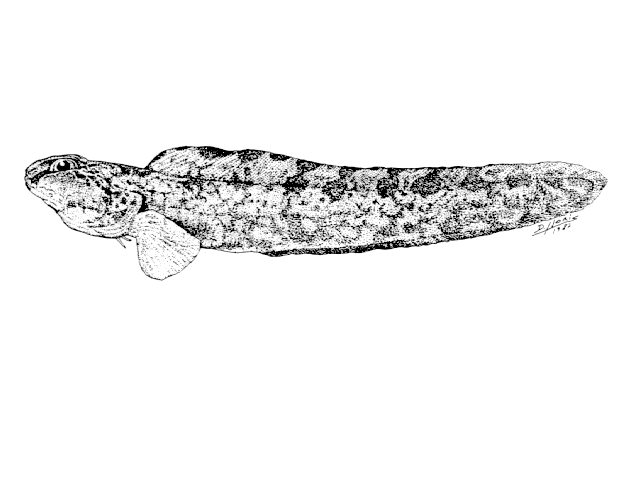| Zoarcidae (Eelpouts), subfamily: Lycodinae |
| 35.58 cm TL (male/unsexed) |
|
demersal; brackish; marine; depth range 0 - 600 m |
| Southeast Pacific and Southwest Atlantic: Chile and Argentina, including Tierra del Fuego (Ref. 27363). |
|
Dorsal spines (total): 0-0; Dorsal soft rays (total): 85-85; Anal spines: 0-0; Anal soft rays: 71-71; Vertebrae: 83-97. This genus is distinguished by the following characters: presence of submental crests, not fused anteriorly; elongated and narrow neurocranium; the frontal bones are totally fused with no trace of a suture, the frontal corner squared; long frontal ramus; the sphenotic and parietal separated by pterotic; parietal bones meet in the mid-line; parasphenoid wing height high; juncture of ceratohyal-epihyal is smooth; branchiostegal rays 5; posterior hyomandibular ramus elongate; well developed palatal arch and posttemporal ventral ramus; scapular foramen enclosed by bone; with scapular strut; 4 notched radials (= actinosts); with postcleithrum; 85 dorsal fin-rays (last 7 counted from dorsal-fin pterygiophores); 71 anal-fin rays (last 10 counted from anal-fin pterygiophores); 18 pectoral fin rays; presence of pelvic bone; vertebrae asymmetrical (21+68=89); ribs on 4?21 abdominal vertebrae; 1 epural; dorsal-fin origin associated with vertebrae 4; well developed oral valve; gill slit extending ventrally to lower end of pectoral-fin base; blunt gill rakers; nub-like pyloric caeca; presence of scales, palatine and vomerine teeth; pale oral cavity; black peritoneum; a blurred brown band between the anteroventral edge of the eye and the upper jaw.
Additional diagnostic characters are the following: frontal and parasphenoid not separated by pterosphenoid; supraoccipital-exoccipìtal articulation excluded by epioccipitals; no supratemporal commissure and occipital pores; ascending rami of the parasphenoid reaches the upper margin of the trigeminofacialis foramen; well developed intercalar, not reaching prootic; 8-9 suborbital bones, canal with 7 pores; postorbital pores 1 and 4; single posterior nasal pore; cartilaginous basal plate of pectoral girdle with three foramina; vertebrae asymmetrical (19-21+ 64-77 = 83-97); dorsal-fin origin associated with vertebrae 2-4; well developed oral valve; blunt gill rakers; pelvic-fin rays ensheathed; squamation extensive, but head and pectoral-fin base and axil have no scales; lateral line mediolateral, palatine teeth 9-23; vomerine teeth 7-17 (Ref. 90127). |
| Found from the intertidal zone and brackish areas out to about 600 m (Ref. 11954). |
|
Not Evaluated (N.E.) Ref. (130435)
|
| harmless |
|
Source and more info: www.fishbase.org. For personal, classroom, and other internal use only. Not for publication.

